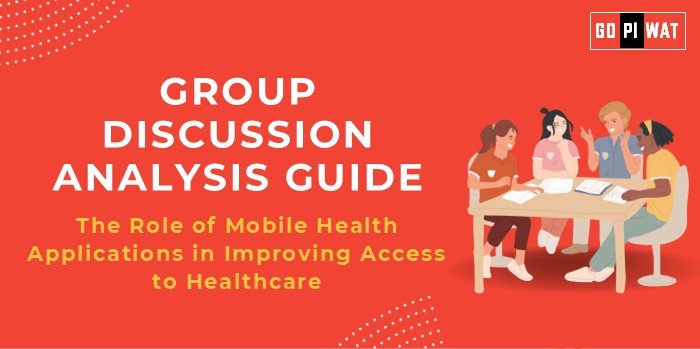📋 Group Discussion (GD) Analysis Guide: The Role of Mobile Health Applications in Improving Access to Healthcare
🌍 Introduction to the Role of Mobile Health Applications
📖 Opening Context
With over 6.8 billion smartphone users worldwide, mobile health applications (mHealth apps) have emerged as a transformative tool in improving healthcare accessibility. The COVID-19 pandemic underscored their importance, fueling exponential growth in telemedicine and self-care solutions.
📜 Topic Background
Mobile health applications use smartphone capabilities to offer diverse healthcare services like teleconsultations, health tracking, medication reminders, and chronic disease management. They bridge gaps in traditional healthcare, particularly in underserved areas, enhancing inclusivity and efficiency.
📊 Quick Facts and Key Statistics
- 🌐 Global mHealth App Revenue: $12.5 billion (2023), projected to reach $50 billion by 2030, showing rapid adoption.
- 📱 User Base: 1.5 billion global active users in 2023, evidencing widespread reliance on health apps.
- 📈 Teleconsultation Growth: 500% increase in usage during the COVID-19 pandemic, transforming healthcare delivery.
- 🏥 Access Gap Bridged: 60% of rural patients in India rely on mHealth apps to connect with urban specialists.
🤝 Stakeholders and Their Roles
- 🏥 Healthcare Providers: Offering digital consultations and improving patient engagement.
- 🏛️ Governments: Ensuring regulatory frameworks and subsidizing health tech innovations.
- 💼 Private Companies: Driving innovation with AI-based diagnosis and wearable integration.
- 👥 Patients: Benefiting from increased autonomy, accessibility, and preventive care options.
🏆 Achievements and Challenges
✨ Achievements
- 🌍 Increased Access: Apps like Practo and Teladoc expanded care in remote regions.
- 💉 Chronic Disease Management: Tools for diabetes and hypertension monitoring reduced hospital visits by 30%.
- 🚑 Emergency Response: Apps like Zocdoc provide faster access to specialists, improving emergency outcomes.
- 💰 Cost Efficiency: 40% reduction in consultation costs via telemedicine apps.
⚠️ Challenges
- 📉 Digital Divide: Limited smartphone penetration in rural areas creates disparities.
- 🔒 Data Security: Breaches, such as the 2023 Zocdoc case, erode trust.
- ⚖️ Regulatory Issues: Varying international guidelines hinder global interoperability.
🌎 Global Comparisons
- 🇪🇪 Estonia: Integrated e-health systems with seamless app usage.
- 🇨🇳 China: Robust mHealth adoption with government-backed platforms like Ping An Good Doctor.
📖 Case Studies
India: Aarogya Setu’s role in tracking COVID-19 cases and disseminating health information.
Kenya: mHealth apps like M-Tiba enable healthcare savings and payments via mobile.
💡 Structured Arguments for Discussion
- 👍 Supporting Stance: “Mobile health apps democratize healthcare by bringing specialists to patients’ fingertips, bridging accessibility gaps.”
- 👎 Opposing Stance: “The digital divide and cybersecurity concerns limit the inclusivity and reliability of mHealth apps.”
- ⚖️ Balanced Perspective: “While mobile health apps revolutionize access to healthcare, achieving universal usability requires addressing digital literacy and regulatory challenges.”
📈 Effective Discussion Approaches
🔑 Opening Approaches
- 📊 Statistic-Based: “60% of rural patients in India use mHealth apps to access specialists…”
- 📖 Case-Based: “Kenya’s M-Tiba app ensures healthcare savings and payments through mobile.”
🤔 Counter-Argument Handling
- 💬 Challenge: “Apps are inaccessible to digitally illiterate populations.”
- 💡 Rebuttal: “Educational initiatives, like India’s Digital Saksharta Abhiyan, aim to improve digital literacy.”
🔍 Strategic Analysis of Strengths and Weaknesses
- 🌟 Strengths: Increased accessibility, cost-efficient care.
- ⚠️ Weaknesses: Limited rural penetration, data privacy concerns.
- 🚀 Opportunities: AI-driven diagnostics, integration with wearable tech.
- ⚡ Threats: Regulatory hurdles, market saturation.
📚 Connecting with B-School Applications
- 🌐 Real-World Applications: Explore mHealth as a theme for projects in healthcare innovation or technology management.
- 💬 Sample Interview Questions:
- 💭 “How can mHealth apps address healthcare disparities in rural areas?”
- 📜 “Discuss the challenges of regulating global mHealth applications.”
- 💡 Insights for B-School Students:
- 📊 Investigate AI in mHealth solutions.
- 📈 Explore partnerships for scaling mHealth in emerging markets.


